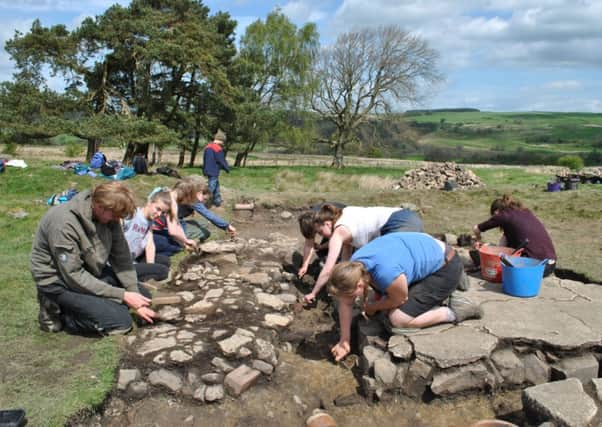Poignant tale unearthed of comrades in arms


IF you venture up to Colsterdale, deep in the heart of the Yorkshire Dales, it’s hard not to be impressed by its vast, rugged beauty.
It can seem at times like an empty wilderness but if you look closer at the southern slopes of Breary Banks you will notice a simple stone cairn, a physical reminder of a poignant chapter in the story of the First World War.
Advertisement
Hide AdAdvertisement
Hide AdFor this memorial commemorates the 15th Battalion (1st Leeds) West Yorkshire Regiment, also known as the Leeds Pals, who lived and trained here for several months before heading to the battlefields not only of the Western Front, but also the Middle East.
Today, there is little evidence of the hundreds of huts and buildings that once stood on these grassy slopes having long since been reclaimed by nature. However, with the help of archive maps, aerial photographs and archaeological excavation, the story of the wartime camp at Breary Banks is being pieced together.
Around 40 archaeology students from the University of York, led by Dr Jonathan Finch, have been working on the project which connects the rural landscape of Yorkshire with the Great War. “It’s the first time anyone has been able to get a detailed and accurate picture of the site,” says Dr Finch.
The project is part of the National Lottery Funded Nidderdale Area of Outstanding Natural Beauty and the First World War: Leeds Pals, PoWs and the Home Front – which looks at the impact the war had on local landscapes and communities.
Advertisement
Hide AdAdvertisement
Hide AdBreary Banks was first established in 1903 as a camp for workers constructing the Leighton and Colsterdale reservoirs and at its peak was home to more than 700 men and their families who lived in rows of huts organised into streets.
When war broke out in 1914 the site became a training camp for a thousand men of the newly formed Leeds Pals battalion, who had answered Lord Kitchener’s call to arms. Together they spent six months living, eating and sleeping in this ready-made village using the surrounding hills as a scenic training ground – a far cry from the muddy horrors that lay in store.
The project has been operating for the past two years and so far the team has concentrated on the south side of the camp, with the aim of extending the excavation work next summer. “We only have a few artefacts that we know definitely came from this period of the camp’s history, but we have found a few things like a teacup with army initials inscribed on the bottom,” says Dr Finch.
The dig has also unearthed all kinds of bottles and ceramics used by those who passed through the site. “The camp had a series of communal and auxiliary buildings. It had piped water, electric lights and all the mod cons of the time; it was like a mini town or village.”
Advertisement
Hide AdAdvertisement
Hide AdDr Finch says the Pals did their initial training at Colsterdale. “They spent a winter there which would have been a shock to the system because some of them were still in tents, so it wasn’t very comfortable. But it was important because they bonded together in the Yorkshire landscape. Some of them knew each other or had worked together before the war and they were all comrades by the time they left.”
This carefree spell in the Dales was described by one of the Pals as the best time of their lives and was a prelude to their brigade training in Ripon. “They were then shipped off to Egypt and came back just in time for the first day of the Somme, which proved to be the end for some of them.”
After the Pals left, Breary Banks continued its wartime service when it became a prisoner of war camp for German officers. “When they first arrived they were virtually starving and although local people were suspicious there’s no evidence that they were badly treated.” In fact a Red Cross Report even said that Breary Banks was one of the best PoW camps in the country.
More than 500 men were housed there and archive material provides a fascinating glimpse into what life was like for the prisoners who busied themselves with music and art classes.
Advertisement
Hide AdAdvertisement
Hide Ad“There was a diverse mix of people,” says Dr Finch. “There were two distinct types of officer, there were those who were very eager to find out any news from the front about how the war was going, but there was another group, including artists and musicians, who were glad to be out of the fray. A couple of the artists who did modern watercolour paintings even went on to become part of the Bauhaus movement after the war.”
Many of the camp guards were invalided British soldiers who, like their prisoners, understood the cost of war. But that’s not say there wasn’t any animosity – for instance prisoners were forbidden from putting up pictures of the Kaiser.
Dr Finch says the camp at Breary Banks is important for a number of reasons. “It’s one of the best preserved training camps we have. There was one in Skipton but that has been built on, whereas this rather wild spot has just been grassed over. So this is important in terms of our national landscape during the First World War because most of the important sites are in Flanders and France and here we have one right on our doorstep.”
It’s also inextricably linked to the Leeds Pals and as with everything poignant about this colossal conflict, it’s the stories that move us.
And here, in this remote corner of Yorkshire, is a story that ties two nations together as well as the lives of some of the young men who went off to fight.